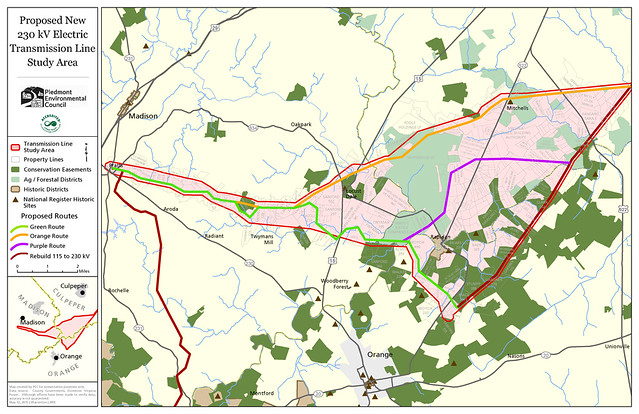This past May, 125 people gathered at the Rapidan fire hall to discuss how to protect the community and its historic and scenic landscape from Dominion’s newly proposed Remington-Pratts-Gordonsville Transmission Project.
From PEC’s initial look, the new 230kV line is expensive and doesn’t address local needs. At best, it provides some additional redundancy. More likely, it’s part of Dominion’s long-term effort to build a bigger transmission system that allows them to sell more power outside of Virginia.

PEC and the newly formed Orange Madison Culpeper Alliance (OMC) hosted the May meeting to provide information and discuss next steps. Since then, Dominion has added a new routing proposal (the “‘purple route”), and it runs through the heart of the study area.
During the meeting, we discussed the permitting process that the State Corporation Commission (SCC) will conduct, which is a process that begins with a filing of an application, expected in early June. We also showed the destructive impact of the proposals on the community, agricultural operations, historic resources and the scenic character of the area.
There is a need to engage elected officials now, securing resolutions from the Board of Supervisors, and reach out to Delegates, Senators and candidates running for office. OMC effectively organized participation and action at the Madison Board of Supervisors, which occurred on the same night as the Rapidan meeting. Additionally, we will need help from elected officials to improve state code related to the way the SCC evaluates new transmission lines and how they weigh the true costs to communities and ratepayers.
We also spoke of coming changes to the routes proposed for the study area. Conservation easements have largely been avoided in two of the three routes (green and purple). But these possible routes snake and weave through the area, often following the borders of protected parcels and becoming a blight for much of the historic landscape. All three options will be submitted to the SCC as a part of the application, including the orange option, which runs through land that is under consideration for conservation easement by the Virginia Outdoors Foundation.
If any of these options are constructed, the new 230kV transmission line would devalue past and future conservation efforts and reduce the scenic qualities that attract tourists. They would also become an eyesore for a landscape that has remained largely intact over the last 200 years.
Next Steps
Please take this opportunity to get involved now by taking the following actions:
- Write or call elected officials and candidates.
- Join PEC and OMC Alliance in this fight (contribute and become members).
- Encourage your friends and neighbors to sign up for PEC action alerts at www.pecva.org/signup to receive updates and learn about opportunities to particpate in the SCC process and future community meetings.
To learn more, visit www.pecva.org/rpg-line
Proposed Warrenton-Wheeler-Gainesville Transmission Line
For the past few years, elected officials and residents of Fauquier and Prince William Counties have met with Dominion representatives to discuss route options for something known as the “Warrenton-Wheeler-Gainesville Reliability Project.” While no route option would be free of negative impacts, some options were decidedly worse than others, similar to the Remington-Pratts-Gordonsville line.
With Dominion’s transmission line proposals in the Piedmont region, we have to ask, “Is there a larger objective?” There’s a proposal for a Haymarket line, Remington-Pratts-Gordonsville line, and the Warrenton Wheeler Gainesville line, and if constructed, it would form a 230kV transmission backbone through the northern Piedmont. We believe it is prudent to raise the issue that these proposals may be segmented in their permitting as an attempt to avoid any cumulative assessment on impacts and need for a larger transmission line and objective. What the Commonwealth and our region can ill afford is a larger, more costly line intended to serve corporate purposes and not the specific needs or greater good of the public.
This article was featured in our Summer 2015 Member Newsletter, The Piedmont View. You can read more of the articles online or view a PDF of the winter issue.
